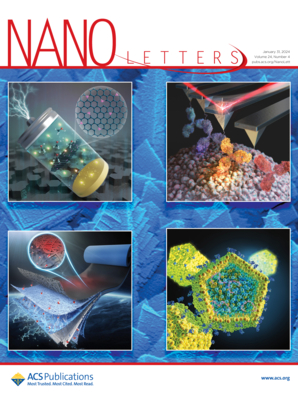Fe Atomic Monolayer in a Coherent Interface: Electrostatic Potential-Induced Segregation and Interfacial Magnetism
IF 9.6
1区 材料科学
Q1 CHEMISTRY, MULTIDISCIPLINARY
引用次数: 0
Abstract
Interfaces and boundaries often trap various impurities so that they play a crucial role in tailoring the mechanical and physical properties of materials and devices. Due to the perfect lattice matching, impurity segregation at coherent interfaces and the corresponding effects on material properties have rarely been reported. In this study, we demonstrate the segregation of an Fe atomic monolayer in a Sr3MgSi2O8/SrTiO3 coherent heterointerface and the resulting interfacial magnetism by combining aberration-corrected transmission electron microscopy, magnetic force microscopy, and first-principles calculations. It is revealed that the segregated Fe atomic monolayer consists of Fe3+ ions and exhibits ferromagnetism. The Sr3MgSi2O8/SrTiO3 coherent interface shows no strain concentration with the Fe segregation driven by the minimization of interfacial electrostatic potential. These findings could deepen our understanding of impurity segregation at coherent interfaces. The as-received interfacial magnetism at the coherent interface is expected to play important roles in applications of future spintronic nanodevices.

界面和边界通常会捕获各种杂质,因此它们在调整材料和设备的机械和物理特性方面发挥着至关重要的作用。由于完美的晶格匹配,相干界面上的杂质偏析及其对材料性能的相应影响鲜有报道。在本研究中,我们通过结合像差校正透射电子显微镜、磁力显微镜和第一原理计算,证明了 Sr3MgSi2O8/SrTiO3 相干异质界面中铁原子单层的偏析以及由此产生的界面磁性。结果表明,离析的铁原子单层由 Fe3+ 离子组成,具有铁磁性。Sr3MgSi2O8/SrTiO3 相干界面没有显示出应变集中,界面静电势最小化推动了铁偏析。这些发现加深了我们对相干界面杂质偏析的理解。相干界面的界面磁性有望在未来自旋电子纳米器件的应用中发挥重要作用。
本文章由计算机程序翻译,如有差异,请以英文原文为准。
求助全文
约1分钟内获得全文
求助全文
来源期刊

Nano Letters
工程技术-材料科学:综合
CiteScore
16.80
自引率
2.80%
发文量
1182
审稿时长
1.4 months
期刊介绍:
Nano Letters serves as a dynamic platform for promptly disseminating original results in fundamental, applied, and emerging research across all facets of nanoscience and nanotechnology. A pivotal criterion for inclusion within Nano Letters is the convergence of at least two different areas or disciplines, ensuring a rich interdisciplinary scope. The journal is dedicated to fostering exploration in diverse areas, including:
- Experimental and theoretical findings on physical, chemical, and biological phenomena at the nanoscale
- Synthesis, characterization, and processing of organic, inorganic, polymer, and hybrid nanomaterials through physical, chemical, and biological methodologies
- Modeling and simulation of synthetic, assembly, and interaction processes
- Realization of integrated nanostructures and nano-engineered devices exhibiting advanced performance
- Applications of nanoscale materials in living and environmental systems
Nano Letters is committed to advancing and showcasing groundbreaking research that intersects various domains, fostering innovation and collaboration in the ever-evolving field of nanoscience and nanotechnology.
 求助内容:
求助内容: 应助结果提醒方式:
应助结果提醒方式:


